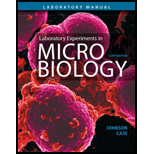
Concept explainers
To write:
The effectiveness of autoclaving, boiling, microwaving and dry heating.
Introduction:
Sterilization is the killing or removal of all the living microorganisms, including the bacterial spores that are highly resistant. It is usually carried out by autoclaving or moist heating, boiling, microwaving and dry heating as the effective methods and consists of maximum exposure to steam as well.
Explanation of Solution
Autoclaving is a moist heat sterilization method that uses high-pressure steam. This process works by the concept that the boiling point of water or steam increases when it is under pressure. The steam inside the autoclave attacks the microorganisms and kills them. Boiling is a simple method of heating water to a high temperature of 100°C, kills most of the pathogenic microorganisms.
Microwaving is a thermal process and most of the processed foods are heat treated to kill the microorganisms. It does not kill the microorganisms completely. Dry heating kills or removes all the microorganisms, including bacterial spores. It requires a longer time for exposure as well as higher temperatures as well. Its higher temperature kills the microorganisms using a destructive oxidation method. Moist heating or autoclaving is the most effective way of killing all the microorganisms, because of its ability to penetrate microbial cells. It is followed by dry heating and then, boiling is effective as it produces heat more thoroughly and flashover can be avoided as compared to microwaving.
Thus, the effectiveness of moist heating or autoclaving is the highest, followed by dry heating that requires longer time and the temperature, then boiling with temperature of 100°C and lastly, microwaving which is a thermal process.
Want to see more full solutions like this?
Chapter 22 Solutions
Laboratory Experiments in Microbiology (12th Edition) (What's New in Microbiology)
- C MasteringHealth MasteringNu X session.healthandnutrition-mastering.pearson.com/myct/itemView?assignment ProblemID=17396422&attemptNo=1&offset=prevarrow_forwardIf left untreated, most HIV-infected individuals will develop AIDS. Current treatments are focused on highlyactive antiretroviral therapy (HAART). HAART usually consists of an orally delivered drug cocktail containingtwo different reverse transcriptase inhibitors and one other drug, such as a protease inhibitor. Question: Develop a pharmacokinetic model of HAART treatment. Consider all 3 drugs. Make sure to include adiagram that illustrates your thinking, state all assumptions, and define your variables. Whatparameters would you need to know to find the concentration of drug in the plasma? In the T cells?(You do not need to write out or solve any equations.)arrow_forwardnot use ai pleseaarrow_forward(A) 25 20 20 15 NPP (Mg C/ha/yr) 10 10 5 0 0 2,000 4,000 6,000 ECOLOGY 4e, Figure 20.11 (Part 1) 2017 Sinauer Associates, Inc. Average annual precipitation (mm) 8,000arrow_forwardexplain the cascade of events (starting with relaxing trade winds) that occurs during El Niño in the eastern Pacific (off the coasts of California/North America and Peru/South America) and which lead to food-chain collapse - start with changes in the physical/oceanographic conditions, andthen systematically describe the cascading effects at each level of the food chain -arrow_forward3) Which statement(s) about the Pacific Decadal Oscillation (PDO) is/are TRUE? CIRCLE ALL THAT APPLY. A. It is a major driver of salmon populations in the Pacific B. It affects sea surface temperatures in the eastern Pacific C. Its cycles typically do not last as long as those of ENSO D. Evidence that it has occurred over many centuries has been gathered from tree ring dataarrow_forward4.arrow_forward2arrow_forward1. 2. 3. Marine fish cells are hypotonic compared to their seawater environment; their cells lose water by osmosis and gain solutes. If you add heterotrophic respiration and autotrophic respiration together and then subtract that value from gross primary productivity, then you have a more refined estimate of ecosystem carbon storage than NEE. Differential heating due to the earth's tilt generates the global wind AND oceanic circulation patternsarrow_forwardarrow_back_iosSEE MORE QUESTIONSarrow_forward_ios
 Principles Of Radiographic Imaging: An Art And A ...Health & NutritionISBN:9781337711067Author:Richard R. Carlton, Arlene M. Adler, Vesna BalacPublisher:Cengage Learning
Principles Of Radiographic Imaging: An Art And A ...Health & NutritionISBN:9781337711067Author:Richard R. Carlton, Arlene M. Adler, Vesna BalacPublisher:Cengage Learning- Surgical Tech For Surgical Tech Pos CareHealth & NutritionISBN:9781337648868Author:AssociationPublisher:CengageBasic Clinical Lab Competencies for Respiratory C...NursingISBN:9781285244662Author:WhitePublisher:Cengage





